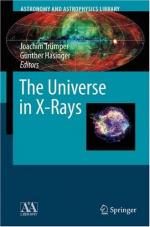|
This section contains 792 words (approx. 3 pages at 300 words per page) |

|
X-ray astronomy is a product of the space age, and is one of the fastest-growing fields of astronomy. It involves not only X-ray stars, but galaxies, pulsars, quasars, and black holes as well.
X-rays had been discovered quite by accident in 1895 by German physicist Wilhelm Röntgen. He noticed that barium crystals, which he had stored across the room, fluoresced whenever he turned on a cathode-ray discharge tube. He correctly surmised that a previously unknown form of radiation of very short wavelengths, which he called X-rays, caused the crystals to glow.
Stars radiate energy in many other wavelengths than visible light, which is only one small part of the electromagnetic spectrum. At the long-wavelength end are low-energy infrared and radio wavelength regimes; at shorter wavelengths than the visible part of the spectrum are high-energy ultraviolet radiation, X-rays, and gamma rays.
There are two broad areas...
|
This section contains 792 words (approx. 3 pages at 300 words per page) |

|


